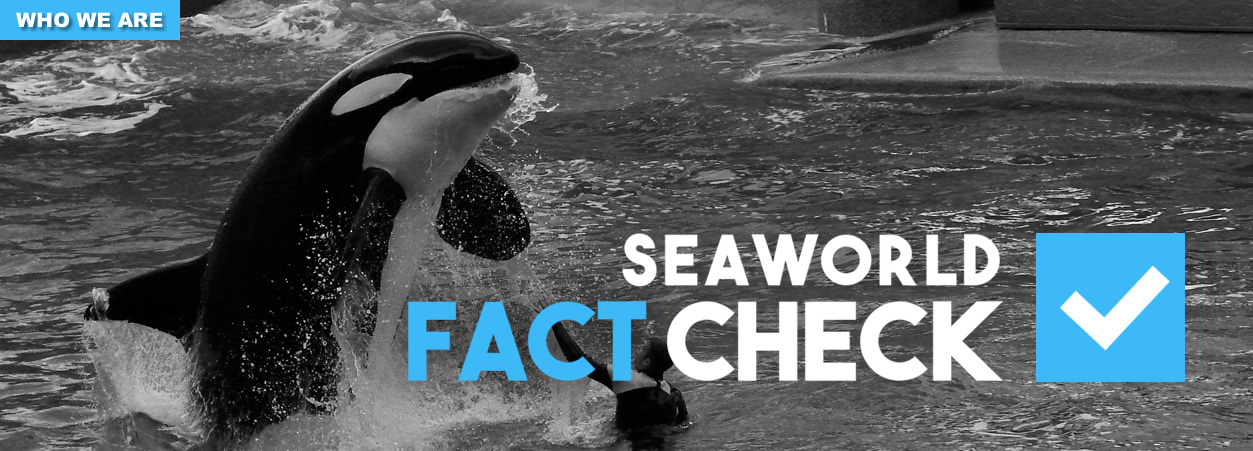SEAWORLD FACT CHECK:
SeaWorld has not rescued any orcas, although it has provided financial support and advice when others have done so. The company lists three incidents where it claims credit for having rescued orcas:
The Barnes Lake, Alaska Rescue1
According to the reference SeaWorld provides, the company contributed financial support. In addition it sent two representatives to the site: SeaWorld San Diego’s assistant curator of animal care, Bill Winhall, and general curator Jim Antrim, who had previously participated in orca captures for SeaWorld2.
The preliminary report referenced by SeaWorld notes that the park would play a role if the orcas stranded after an attempt was made to herd them back to sea. When it was determined that the orcas were an offshore ecotype, the National Marine Fisheries Service took charge of the rescue and SeaWorld played no further role.
In 1983, SeaWorld obtained a permit to capture 100 Alaskan orcas, “90 of which were to be temporary capture for study and 10 to be sent to Sea World marine parks, but the company was forced to leave Alaska empty-handed. In a three-year court battle, the permit was legally challenged, lost, appealed and lost again; but again, the key was overwhelming public sentiment against taking orcas3.”
Morgan4
In June 2010, a young female orca (estimated to be between 3-5 years of age) was found swimming off the coast of the Netherlands. She was alone, dehydrated and emaciated. Later, from analysis of her calls and DNA, it was established that she was originally from Norway. The Dutch government issued a permit to Dolfinarium Harderwijk to capture, rehabilitate and release this orca (later called Morgan). In 2011, Morgan was given a clean bill of health before being transferred to Loro Parque, a marine theme park in the Canary Islands, Spain, to join six other orcas (all owned by SeaWorld).
Given the circumstances, this was thus less a rescue than a “salvage” (i.e., repurposing of an item). A number of court appearances5 were made on Morgan’s behalf before she was transferred from the Netherlands. Objections were raised to her being placed in a concrete tank, as her capture permit clearly stated that a rehabilitation attempt must be made6, but the Dutch Court ruled against Morgan.
On April 8, 2013, SeaWorld filed an amended Form S-1 prospectus for its Initial Public Offering (IPO) with the Securities and Exchange Commission7. On p. 73, this document listed that SeaWorld owned seven orcas (thus including Morgan) held at Loro Parque8. The facility in Spain was used as “additional housing capacity for our killer whales.” This prospectus confirmed that Morgan had been traded in some way to SeaWorld. Wolfgang Kiessling, owner of Loro Parque, has stated that Morgan will be a “new blood line” used for breeding with the SeaWorld orcas9.
Pascualita in Mexico10
In 2007 a calf estimated to be about two weeks old was found on the beach near Puerto Vallarta, Mexico. Attempts to return her to the ocean failed and she was taken to nearby Dolphin Adventure, a local dolphinarium, where she died two months later. SeaWorld and the owners of Dolphin Adventure attempted to transfer the young whale to SeaWorld, but that attempt was blocked by the Mexican Government and concerned NGOs due to fears that it would set a precedent of animal trafficking.
1 http://whale.wheelock.edu/archives/whalenet95/0056.html
2 http://www.pbs.org/wgbh/pages/frontline/shows/whales/interviews/hall3.html
3 http://www.pbs.org/wgbh/pages/frontline/shows/whales/keiko/world.html
4 http://articles.orlandosentinel.com/2011-07-19/business/os-seaworld-killer-whale-morgan-20110719_1_loro-parque-killer-whale-experts-killer-whale
5 http://www.freemorgan.org/latest-news/
6 http://www.freemorgan.org/law-experts-publish-on-morgans-legal-status/
7 http://www.sec.gov/Archives/edgar/data/1564902/000119312513145346/d448022ds1a.htm
8 http://articles.orlandosentinel.com/2005-12-09/news/SEAWORLD09_1_loro-parque-seaworld-whales
9 http://www.freemorgan.org/pdfs/EL-DIA-es-1-December-2011-Morgan-for-Breeding-with-English-Translation.pdf
10 http://www.chron.com/news/nation-world/article/Baby-killer-whale-beaches-self-along-Mexico-s-1826531.php; http://www.reuters.com/article/2007/06/12/idUSN11199280
_____________
SEAWORLD SAYS:
Yes, though killer whales do not beach with the same frequency as other species, and when they do it is typically a last ditch effort at survival. If a killer whale comes ashore, it is generally gravely ill, injured, malnourished, dehydrated, very old or very young, and it does not survive long. Nonetheless, we’ve assisted whales many times, including killer whales.
The largest whale to ever be rescued, rehabilitated and returned to the wild — J.J. the orphaned gray whale calf — was part of our rescue program. (See the attached paper from a biologist at the Hubbs-SeaWorld Research Institute (PDF).)
You can read about our role in rescuing killer whales from Barnes Lake in Alaska here. We also assisted our colleagues at Dolfinarium in Holland with veterinary care and husbandry for Morgan, an orphaned and hearing-impaired juvenile killer whale they rescued. SeaWorld was also part of the team to help a young killer whale stranded near Puerto Vallarta in Mexico.
An equally important part of working to understand the health of wild killer whales is studying the whales that do not survive a stranding event. We are regularly called upon for pathology studies and SeaWorld veterinary pathologists have contributed to a new manual that will standardize the scientific approach to these post mortem exams to maximize the learning opportunity gained from these unfortunate outcomes.
|

